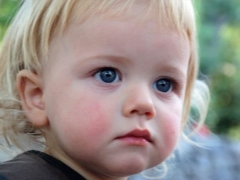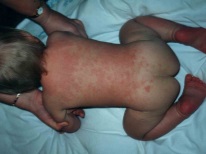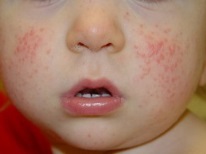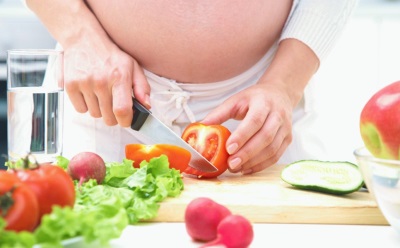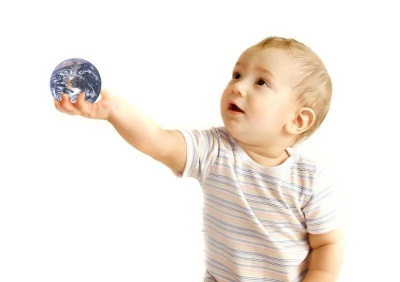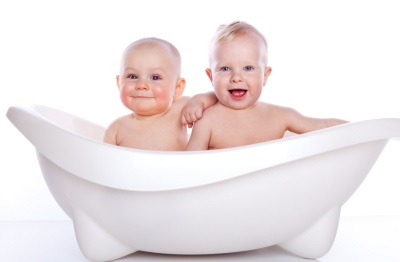Diathesis in a child and methods for its treatment
Speaking about the diathesis in the child, the mother usually means redness on the cheeks or a rash on the baby's buttocks. This is how diathesis really manifests itself, but only one of its types. What are the diathesis in children, how to identify them, is it possible to prevent and what is the best treatment?
What is it?
The term “diathesis” in medicine refers to the inclination of babies to certain diseases. Most often, diathesis is called the manifestation of allergy on the baby’s skin, but this is dermatitis, the cause of which may be one of the diathesis - exudative catarrhal.
It is accepted to call diathesis in particular the manifestations in childhood of the reaction to different stimuli when the baby’s body responds inadequately (pathologically). Diathesis is not a clinical diagnosis, but can cause various diseases. About diathesis in infants read in another article.
Kinds
Pediatricians distinguish several types of diathesis, among which the most common are:
- Lymphatic-hypoplastic. Judging by the name, this diathesis affects the lymphatic system of the child. It also affects the endocrine and immune systems.
- Exudative-catarrhal. This type of diathesis is predominant, and when it comes to diathesis, it is often meant it.
- Neuro-arthritic. In such a diathesis, a child is noted to have an increased excitability and disorders of the exchange of salts, because of which it is also called uric acid.
The reasons
First of all, diathesis develops under the influence of genetic factors, when the features of the work of internal organs and metabolic processes are transferred to the baby from its parents. Also, various damaging effects that affect the baby during the period in the womb and during childbirth lead to the development of diathesis. In addition, the body of the baby in the first years of life is not yet fully developed and works a little differently than the body of an adult. This causes the emergence of different types of diathesis.
The factors provoking each type of diathesis, consider:
Type of diathesis | Factors |
Neuro-arthritic |
|
Exudative catarrhal |
|
Lymphatic-hypoplastic |
|
Is it possible to prevent?
In many cases, diathesis appears as a result of heredity, and it will not work to affect it. At the same time, some children “outgrow” this state without any consequences, while other babies can develop serious diseases. And the actions of parents under the guidance of doctors are able to prevent the occurrence of such diseases.
Nevertheless, considering the factors provoking diathesis, it can be noted that the risk of its development will be reduced if the mother rationally feeds and protects herself from infections. Rational feeding of a newborn, prevention of infections and colds, timely treatment of diseases will also help reduce the likelihood of diathesis.
Symptoms
Exudative catarrhal
The main symptom of exudative catarrhal diathesis is the tendency to allergies, which is manifested by dermatitis. The baby becomes red cheeks, on the body may appear rash of different types and sizes. Also on the hair and cheeks of the baby can form dense scales and crusts. Affected skin may begin to get wet, crack, be infected.
After six months, dermatitis often appears as a rash on the limbs, often localized in the folds under the knees and elbow joints. In the area of the ankle joints and wrists, a small-aelastic rash may occur. As a rule, the elements of the rash are quite itchy.
Other manifestations of this form of diathesis are:
- Prickly heat and diaper rash. Such symptoms quickly appear, it is worthwhile for the child to stay in too hot conditions for a short time or not to change the crumbs of the diaper at the wrong time.
- Frequent inflammations of the mucous membrane of the eyes and mouth.
- Increased tendency to colds and colds.
- Excess weight gain.
Lymphatic-hypoplastic
The main symptom of a lymphatic-hypoplastic type of diathesis is an increase in the lymph nodes of the child. They are found when feeling and can be the size of a bean or pea, while they are not painful.
Other signs of such a diathesis are:
- Pallor and flabbiness of the child’s skin, puffiness.
- Rapid fatigue, lethargy, apathy.
- Poor development of muscle mass, excess weight.
- An increase in adenoids, leading to prolonged rhinitis, a violation of nasal breathing.
- Thymus enlargement, which is often detected during chest radiographs. Because of him, the child may have hoarseness, shortness of breath during sleep, coughing for no reason.
- Frequent infections. Usually in children with such diathesis, acute respiratory viral infections occur more often six times a year and pass with symptoms of severe intoxication.
Neuro-arthritic
The main symptom of neuro-arthritic diathesis is a significant nervous excitability of the baby. In infants, she manifests loud crying, startling, and in older children - a nervous tic, enuresis, the appearance of night terrors, frequent mood swings, vomiting when overexcited, coughing without ARVI.
Other symptoms of this diathesis can be:
- Frequent child complaints of pain. A child may say that he has a headache, legs or stomach aches, and organic disturbances are not detected.
- Bad appetite.
- Increased body temperature for no reason.
- Frequent acetonemic crises.
Treatment
Features of treatment are determined by the type of diathesis and the symptoms of its occurrence in a child.
Diet
With an exudative-catarrhal form of diathesis, the baby’s nutrition must be hypoallergenic. It is important to keep as long as possible. breastfeeding, while mom should also follow a diet with restriction of allergens.
If the infant had to be fed with the mixture, it is necessary to select a suitable variant that does not cause a reaction with the pediatrician. It’s not worth changing the mixture, for which the child has no allergy, to another option, even if he likes his price, manufacturer, composition or other characteristics more.
It is important to start feeding the baby with diathesis no earlier than 6 months of age. First, the baby is introduced to the hypoallergenic dishes - zucchini puree and rice porridge. In the period of the beginning of feeding the baby should be carefully monitored. A food diary is recommended.
With products such as eggs, fish, juices, chicken and some others, the baby should be introduced a little later than his peers. It is better not to give strong allergens (strawberries, honey, chocolate, nuts, seafood and others) until 2-3 years of age. Food for a child should be prepared independently, since reactions to canned foods are quite common.
Great attention to nutrition should be paid in the neuro-arthritic diathesis:
- The child should eat regularly, without long breaks without food.
- Baby can not be fed by force. If he refuses, gently offer different dishes, but do not intimidate or force.
- The emphasis in nutrition needs to be done on plant and dairy foods. Meat and fish should be limited.
- The child should not be given salted, marinated, canned, smoked and very fatty dishes. It should limit the products in which a lot of purines and salts.
- Drinking regime of the child should be extended.
Medicines
All drugs to eliminate the manifestations of diathesis should be prescribed by a doctor. In the lymphatic-hypoplastic form of diathesis, it is important to treat infections that occur in a child in time to prevent a prolonged course and complications.
During the recovery period, babies are often prescribed medications that strengthen the immune system. In case of neuro-arthritic diathesis, it is necessary to promptly treat acetonemic crisis, which often appears in such children.
Local funds
Creams, emulsions, gels, ointments and other local means of action help to quickly get rid of the manifestations of dermatitis with exudative-catarrhal diathesis. They can be hormonal, for example, advantan or elokom (such agents have a quick and effective action, but side effects are possible) and non-hormonal, for example, phenicyle or elidel. Weeping wounds are treated with lotions with therapeutic solutions of furatsilina, tea, broth oak bark.
To cleanse the skin, you should daily bathe the child in dechlorinated water (before bathing, the water should be kept for at least an hour). To enhance the positive effect of baths, an infusion of herbs can be added to the water (chamomile, a succession, sage), potato starch, brewed wheat bran, decoction of bay leaves.
Baby Care Tips
- For washing both baby clothes and your home clothes, use special soap or powder. After washing things should be ironed.
- Let in the wardrobe of the baby there will be only things from natural fabrics.
- Limit the contact of the baby with soft toys. All rubber or plastic toys that are purchased for an infant should be checked (is there a quality certificate).
- Do not start a pet while the child is small. If the house already has a pet, limit its contact with the baby.
- Try to minimize the number of things in the children's room that can collect dust. Clean the carpet and upholstered furniture, hide the book behind the glass.
- In the children's room should be done daily wet cleaning.
- In case of any disease, you should not give the child any medications until you consult with your doctor, because many drugs can be allergens due to the content of dyes and flavors.
- Cosmetics for baby hair and skin should be from special hypoallergenic series.
- Provide your child with a full sleep at night and at daytime. In this evening you should not play too actively.
- Let the day routine of the child be sure to walk, gymnastics, light massage.
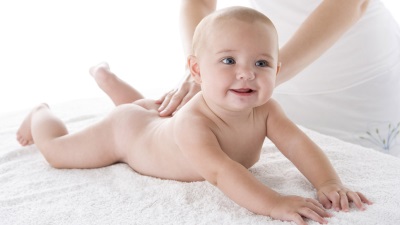
Forecast
The exudative-catarrhal version of diathesis runs to 3-4 years of age in most babies. In the future, these kids without any problems consume milk, red berries, citrus fruits, chocolate and other allergenic products. In some cases, this diathesis gives rise to the development of allergic diseases - bronchial asthma, rhinitis, bronchitis, dermatitis, and others. To prevent them, it is important to carefully adhere to conditions such as a allergic diet, proper care of damaged skin and timely treatment of exacerbations.
The lymphatic-hypoplastic type of diathesis first appears in 2–3 years, but as the body’s immune system improves, it almost always passes by 6–7 years of age. For parents, the main task is to protect the child from infections. They should focus on normalizing the daily routine and nutrition of the baby, as well as tempering. Babies are recommended air baths, douches, douche, feet barefoot, sunbathing, sleep without pajamas.
The neuro-arthritic type of diathesis is distinguished by the most unfavorable prognosis, since it often becomes the cause of various diseases of the nervous system and metabolism. With such a diathesis, the risk of developing diabetes mellitus, gout, inflammation of the joints, kidneys, neurosis, and many other pathologies increases. It is important to protect the child from overwork and excessive loads, to create a favorable psychological setting in the family, to walk daily, take the baby in sports, to teach him relaxation techniques (breathing exercises, light massage).
